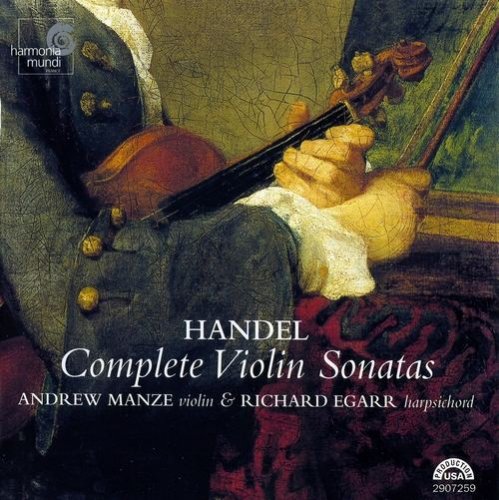Andrew Manze, Richard Egarr - Handel: Complete Violin Sonatas (2004)

Artist: Andrew Manze, Richard Egarr
Title: Handel: Complete Violin Sonatas
Year Of Release: 2004
Label: Harmonia Mundi
Genre: Classical
Quality: FLAC (tracks+.cue,log,scans)
Total Time: 76:43
Total Size: 528 Mb
WebSite: Album Preview
Tracklist: Title: Handel: Complete Violin Sonatas
Year Of Release: 2004
Label: Harmonia Mundi
Genre: Classical
Quality: FLAC (tracks+.cue,log,scans)
Total Time: 76:43
Total Size: 528 Mb
WebSite: Album Preview
Sonata D-Dur Op.1 N.13 HWV 371
1. Affettuoso 3:28
2. Allegro 2:43
3. Larghetto 2:16
4. Allegro 3:37
Sonata F-Dur Walsh Op.1 N.12
5. Adagio 3:46
6. Allegro 3:21
7. Largo 3:07
8. Allegro 3:29
Sonata d-moll HWV 359a
9. Grave 2:12
10. Allegro 1:51
11. Adagio 1:02
12. Allegro 3:29
Sonata A-Dur Op.1 N.3 HWV 361
13. Andante 2:38
14. Allegro 1:52
15. Adagio 0:47
16. Allegro 2:34
Sonata g-moll Op.1 N.6 HWV 364
17. Larghetto 2:08
18. Allegro 1:54
19. Adagio 0:49
20. Allegro 2:21
Sonata A-Dur “Roger” Op.1 N.10
21. Adagio 1:34
22. Allegro 2:38
23. Largo 1:10
24. Allegro 2:34
Sonata E-Dur “Roger” Op.1 N.12
25. Adagio 2:13
26. Allegro 2:57
27. Largo 1:16
28. Allegro 2:39
Sonata G-Dur HWV 358
29. Allegro 1:44
30. Adagio 0:43
31. Allegro 2:18
32. Andante a-moll HWV 412
33. Allegro c-moll HWV 408
Performers:
Andrew Manze – violin (Joseph Gagliano, Napoli, 1782)
Richard Egarr – harpsichord (John Philips, 1993, after Nicolas Dumont, 1707)
As Andrew Manze remarks in the liner note for this album, the sonata was perhaps "but a toy theatre in Handel's world of architectural splendours." Indeed, the eight sonatas, with the addition of two independent movements, provide an insight into a world far removed from the imposing, monumental Handelian works known to many listeners. But these works are by no means a lesser manifestation of the composer's genius. In fact, from the imaginatively compelling fast movements to the meditative melodiousness of the introductory movements, these remarkable works provide the listener with a valuable and memorable insight into the rich -- and sometimes surprising -- musical mind of one of Baroque music's true giants. When discussing these sonatas, scholars make much of Handel's indebtedness to Corelli. While Corelli's influence is undeniable, one should heed Bukofzer's observation that in "many allegro movements, Handel easily surpasses Corelli by his superb handling of lightly fugal textures and his complete mastery of the concerto style." Andrew Manze's artistry beautifully captures the Baroque richness of these works, adapting his instrument's protean voice to the many complexities and contrasts inherent in Handel's musical discourse. Elegant, tastefully expressive, and drawing an unexpected fullness and raw volume from a finely controlled tone, Manze also masterfully expands his instrument's sound potential in an effort -- particularly in certain allegro movements -- to discern the composer's dramatic intentions. As an accompanist, harpsichordist Richard Egarr is the quintessential distant presence, a discreet but essential interlocutor in a musical dialogue in which the two voices essentially blend to create a unitary aesthetic experience.

![Hidefumi Toki - After Dark (2019) [Hi-Res] Hidefumi Toki - After Dark (2019) [Hi-Res]](https://www.dibpic.com/uploads/posts/2025-11/1764245944_folder.jpg)
![Chris Hinze Combination - Sister Slick (2025) [Hi-Res] Chris Hinze Combination - Sister Slick (2025) [Hi-Res]](https://www.dibpic.com/uploads/posts/2025-11/1764317100_v0lb4liiku7ja_600.jpg)





